Indoor gardening can be difficult due to lighting conditions. Fortunately, there are numerous options for low-light indoor plants that you can select from if you lack sunny windowsills.
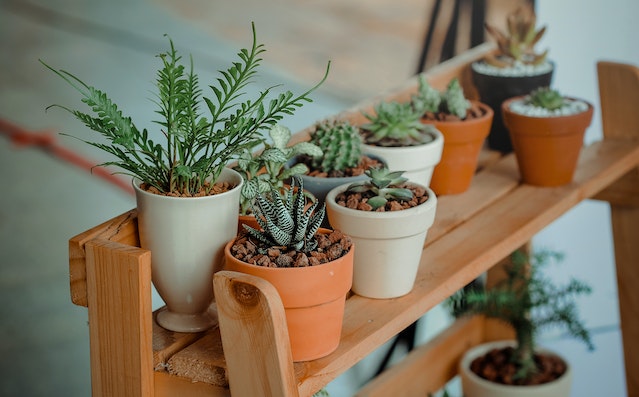
Are you hesitant to attempt to grow indoor plants in your home or a particular room? Do you believe there isn’t sufficient light? Dont worry. These houseplants flourish in low-light conditions and are effortless to cultivate. To determine the kind of light in your room, consider the following:
A south-facing room with ample windows provides high light. An east- or west-facing room is considered medium light.
(Also Read: How to start a successful Etsy Shop?)
Low-light rooms are those that face north or have no windows. If your room lacks windows, keep the lights on for 12 hours per day or temporarily transfer low-light indoor plants to the room for a few weeks before returning them to a naturally lit room.
These houseplants can flourish in your home even without sunlight.
1. Lucky Bamboo
Lucky bamboo plants, which feature sculptural or braided stalks and small green leaves, are versatile plants suitable for both homes and offices. They can be grown in water or soil. According to feng shui principles, they are believed to bring good luck and fortune, especially when received as gifts.
Additionally, these plants are known for their resilience and ability to thrive in low-light conditions. However, it’s important to ensure they are not exposed to drafty areas and are kept away from pets, as they do contain toxic properties.
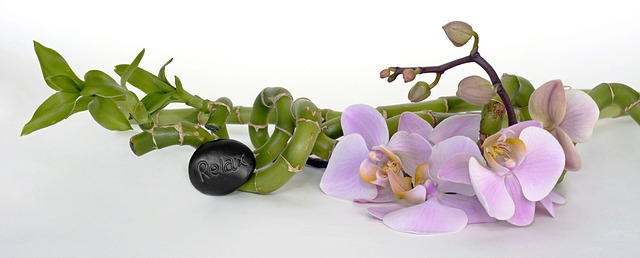
- Leaf Color Varieties: Green Light: Partial shade to full shade
- Mature Size: 1 to 5 feet tall, 1 to 2 feet wide (indoors) Difficulty: Low-maintenanceSpider Plant
2. Spider Plant
The spider plant is a highly adaptable and low-maintenance indoor plant. It derives its name from its star-shaped flowers that develop into spider-like green offshoots, also known as spiderettes. These plants hang from the parent plant’s long and slender green leaves, resembling spiders on a web.
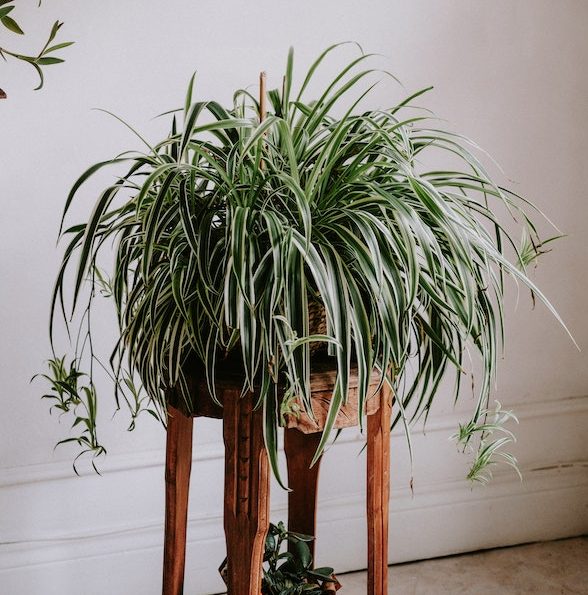
Whether grown in pots or baskets, spider plants can be hung or left to trail. They can thrive in suboptimal lighting, including artificial light, for extended periods of time. To avoid the soil from drying out, regular watering is necessary.
- Leaf Color Varieties: Green or variegated foliage Light: Partial shade
- Mature Size: 1 to 2 feet tall and wide Difficulty: Low-maintenance
3. Golden Pothos
Golden pothos is capable of thriving in environments that are nearly inhospitable for other plants, such as areas with extremely low light and minimal water. With its smooth, leathery, heart-shaped leaves and durable vines, the attractive and low-maintenance golden pothos is considered one of the most beloved indoor plants.
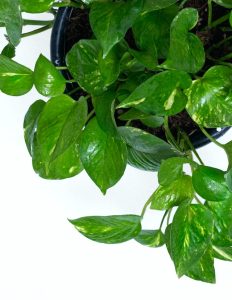
Certain varieties of golden pothos feature uniquely marbled leaves that alternate along green stems that resemble ropes. To avoid the vines from becoming tangled, it’s important to regularly dust and loosen them. However, pet owners should keep the plant away from their furry friends as it is toxic to animals.
- Varieties of Leaf Color: Green or variegated foliage Light: Partial shade to full shade
- Mature Size: 20 to 40 feet long, 3 to 6 feet wide Difficulty: Low-maintenance
4. Snake Plant
If you’re looking for low-maintenance indoor plants that require minimal light, these species are some of the best options available. Their thick sword-like green leaves can grow up to eight feet tall, making them quite striking in appearance.
Also known as mother-in-law’s tongue, the snake plant is a long-lived species that can survive for several decades. Although it prefers to grow in partial shade, it can also endure significantly shady conditions.
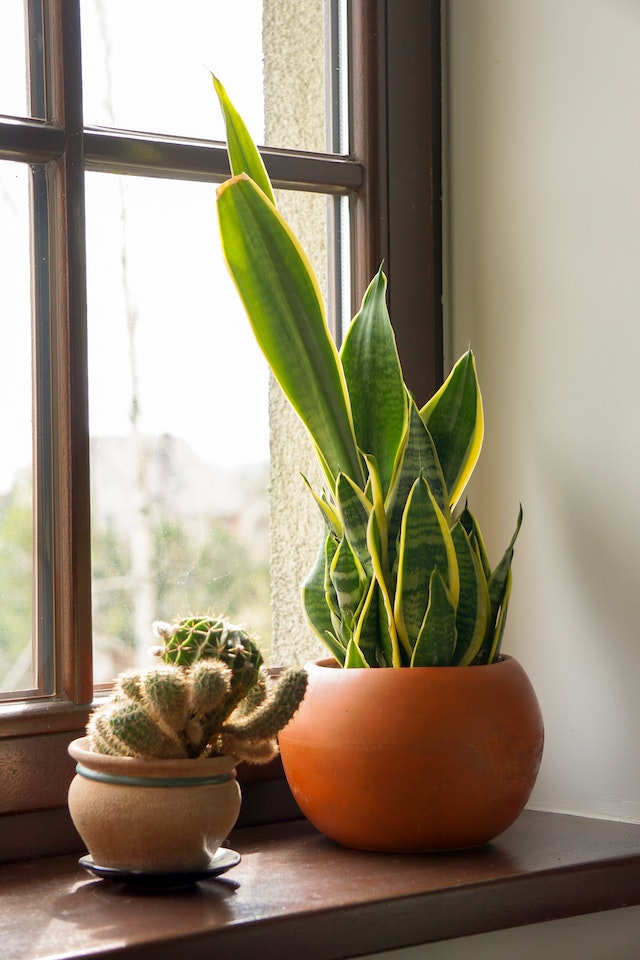
To prevent root rot and avoid killing the plant, it’s crucial not to overwater it, particularly if it’s not exposed to direct sunlight that can dry out the soil. It’s essential to note that snake plants are toxic to pets.
- Color Varieties of Leaf: Deep green foliage with a striped edge and gray-green markings Light: Partial shade
- Mature Size: 6 inches to 8 feet tall Difficulty: Low-maintenance
5. Staghorn Fern
Staghorn ferns are plants that naturally grow on other plants instead of in soil, making them epiphytic. These ferns have distinct green leaves that resemble deer antlers and can grow quite large. As a houseplant, they can be mounted on wooden boards, creating beautiful natural artwork.
Staghorn ferns thrive in shaded areas and can be harmed by direct exposure to sunlight, so it’s important to provide them with a shady spot. It’s also essential to let them dry out completely between watering sessions.
- Leaf Color Varieties: Green Light: Full shade
- Mature Size: 2 to 3 feet tall and wide Difficulty: Expert
6. English Ivy
While English ivy can be used as a ground cover in outdoor settings, it serves as a beautiful trailing plant with small and delicate green leaves in low-light indoor environments.
When grown indoors, it is advisable to place your English ivy in an area that receives indirect light. It is crucial to maintain adequate humidity by misting the plant regularly, and it is best to keep it in a cool room at night, preferably around 60 degrees Fahrenheit.
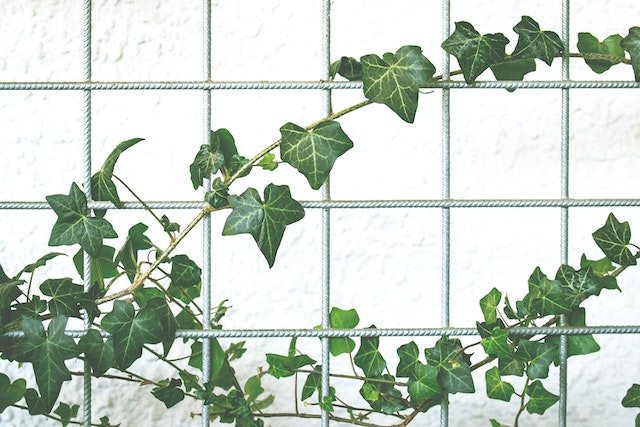
- Leaf Color Varieties: Dark green Light: Partial shade to full shade
- Mature Size: Climbs and spreads as much as possible Difficulty: Needy (indoors)
Moreover, it is important to be mindful of the plant’s growth, as it is toxic to both humans and pets.
7. Cast Iron Plant
Cast iron plants are known for their resilience as indoor plants, earning them a reputation of being nearly indestructible. Their attractive appearance is characterized by large, arching leaves that have a deep green glossy finish.
Cast iron plants have the ability to endure various forms of neglect, such as inadequate light and water. However, it is recommended to water them when the soil feels dry to the touch. Additionally, it’s best to place them in an area with indirect sunlight to avoid damaging the leaves. For optimal growth, a north-facing window would be an ideal location.
Leaf Color Varieties: Dark green Light: Partial shade to full shade
Mature Size: 2 to 3 feet tall, 1 to 2 feet wide Difficulty: Low-maintenance
8. Peace Lily
Peace lilies are a well-liked choice for indoor plants that thrive in low-light conditions and can also endure neglect. They feature sizable, dark green leaves and occasionally produce a rare, elegant white flower. However, they require sufficient watering, or else the leaves will become droopy and wilted.
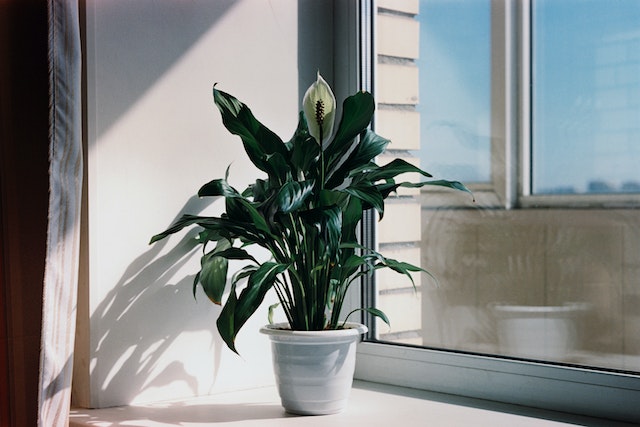
Typically, watering is sufficient to revive the drooping foliage of peace lilies. It’s important to position these plants in an area that receives indirect sunlight since they thrive in shade. It’s essential to keep them out of reach of children and pets because they contain toxic substances.
Leaf and Flower Color Varieties: Dark green foliage, white flowers Light: Partial shade to full shade
Mature Size: 1 to 4 feet tall and wide (indoors) Difficulty: Needy
9. Maidenhair Fern
Maidenhair ferns have dainty, fan-shaped leaves arranged in clusters along dark stems, making them a popular choice for indoor plants that thrive in low-light conditions and bring a splash of greenery to any space. However, these ferns require consistently moist soil, without being too waterlogged, to flourish.
In addition to proper soil moisture, maidenhair ferns prefer a warm and humid environment and should be placed in an area that doesn’t receive direct sunlight.
Leaf Color Varieties: Medium green foliage Light: Partial shade to full shade
Mature Size: 1 to 2 feet tall and wide Difficulty: Needy
10. The ZZ Plant
The ZZ plant is a hassle-free indoor plant that can endure without natural sunlight, making it a popular choice for windowless offices. Its distinctively shiny, broad, oval-shaped leaves grow upwards and are hard to miss.
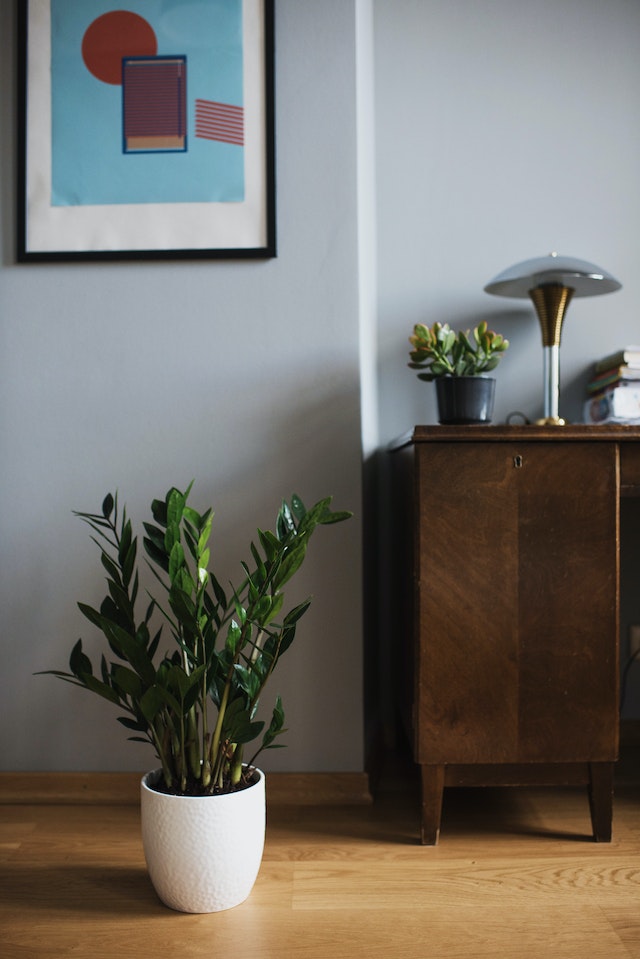
Although the ZZ plant can survive without natural sunlight, it thrives in bright, indirect light. Additionally, they can endure extended periods of drought and should be watered only when the soil has dried out. It’s important to keep these plants out of reach of children and pets as they contain toxic substances.
Leaf Color Varieties: Dark green Light: Partial shade to full shade
Mature Size: 2 to 4 feet tall and wide Difficulty: Low-maintenance
11. Philodendron
Philodendrons are widely favored as low-light indoor plants because of their low maintenance and their ability to bring a lush, tropical atmosphere to any space with their lengthy green vines and heart-shaped leaves. It’s crucial to regularly dust the vines to maintain their appearance.
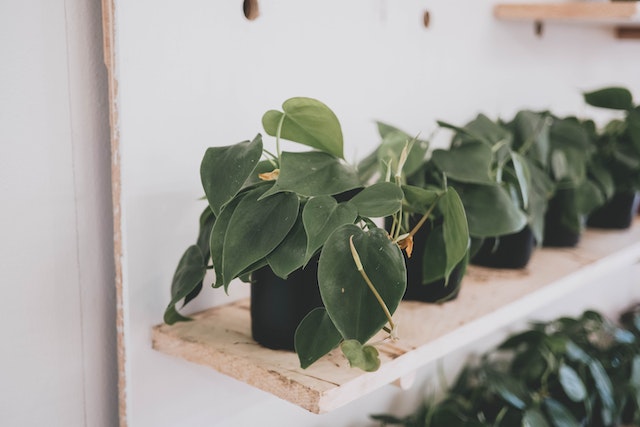
For optimal growth, philodendrons require a window that receives bright, indirect sunlight when placed indoors. Although they can endure low-light conditions, it may cause sparser foliage and leggy stem growth. It’s important to keep philodendrons out of reach of children and pets since they contain toxic substances.
Leaf Color Varieties: Green Light: Partial shade
Mature Size: 10 to 20 feet tall; 3 to 6 feet spread Difficulty: Low-maintenance
12. Anthurium
Anthurium, commonly referred to as the flamingo flower, is a group of tropical plants recognized for their striking flowers and lavish foliage. With adequate humidity and consistently moist soil that isn’t overly waterlogged, these plants can thrive indoors.
Anthuriums do well when placed in an area with bright, indirect light. It’s important to avoid exposing them to direct sunlight since it can scorch the leaves. Additionally, Anthuriums should be kept out of reach of children and pets as they contain toxic substances.
Flower Color Varieties: Red, pink, or white flowers Light: Partial shade
Mature Size: 12 to 18 inches tall, 9 to 12 inches wide Difficulty: Expert
13. Chinese Evergreen
With oval-shaped, glossy green leaves on short stems, the Chinese evergreen is an ideal low-light indoor plants that thrives in shaded areas with low-light indoor conditions. It’s important to keep them away from direct sunlight as it can cause damage to the leaves.
Variegated varieties of Chinese evergreens require bright, indirect light to bring out their best coloration. However, all types of Chinese evergreens can survive in low-light conditions. It’s crucial to keep this plant away from pets since it contains toxic substances.
Leaf Color Varieties: Dark green to silver foliage Light: Partial shade to full shade
Mature Size: 1 to 3 feet tall and wide Difficulty: Low-maintenance
14. Swiss Cheese Plant
The Swiss cheese plant also recognized as the split-leaf philodendron, features sizable, leathery green leaves with striking perforations. These plants are native to shaded areas and flourish when exposed to bright, indirect light when grown indoors.
It’s important to avoid overexposing Swiss cheese plants to direct sunlight, as it can scorch the leaves. Furthermore, these plants contain toxic substances and should be kept away from pets.
Leaf Color Varieties: Green Light: Partial shade
Mature Size: 3 feet tall, 2 to 3 feet spread Difficulty: Low-maintenance
15. Prayer Plant
The prayer plant is a diminutive tropical plant with eye-catching, oval, or round-shaped leaves in various colors. If you offer it a warm and humid environment, it thrives well as an indoor plant.
The prayer plant is known for its low-light tolerance, and exposing it to direct sunlight can harm its leaves. It’s recommended to position the plant near a window that offers bright, indirect light for optimal growth.
Leaf Color Varieties: Deep green leaves with yellow and red markings Light: Partial shade to full shade
Mature Size: 6 to 12 inches tall and wide Difficulty: Needy
16. Silver Pothos
Silver pothos, also referred to as satin pothos, share several similarities with golden pothos, but it stands out with its matte green leaves dotted with silver. These plants flourish indoors, even in areas with limited access to light.
For optimal leaf color, it is best to place the silver pothos in bright, indirect light, but the plant can survive in locations with lower light levels. Regularly misting the plant can help to maintain humidity, which it thrives in. However, it is important to keep silver pothos away from pets as they are toxic.
Leaf Color Varieties: Green and silver Light: Partial shade to full shade
Mature Size: 4 to 10 feet long Difficulty: Low-maintenance
17. Dragon Tree
The Dracaena genus includes the dragon tree, which can grow its upright, sword-like leaves with red edges even in shady conditions. This plant is low-maintenance and resilient, making it easy to care for.
The dragon tree, which belongs to the Dracaena genus, is a low-maintenance plant that can grow its red-edged, sword-like green leaves in shady conditions. When grown indoors, it typically stays under six feet tall and only needs repotting every two to three years. It prefers a window that receives bright, indirect light, although it can survive in lower-light settings, which might result in smaller leaves. However, keep in mind that this plant is toxic to pets.
Leaf Color Varieties: Green Light: Partial shade
Mature Size: 15 to 20 feet tall, 3 to 10 feet wide Difficulty: Low-maintenance
18. Wax Bagonia
Wax begonias are delightful small plants with shiny leaves in bronze, green, or maroon hues, and vibrant blooms. They are perfect for those seeking low-maintenance houseplants to add to their collection.
Wax begonias are low-maintenance plants with glossy bronze, green, or maroon leaves and colorful blooms that make them an excellent addition to your indoor garden. They prefer a shaded environment, both indoors and outdoors, as direct sunlight can be stressful for them. A bright window that receives indirect light is ideal for maximum blooming.
However, they can also grow in low-light indoor conditions. These plants are toxic to pets, so it’s important to keep them out of reach.
Flower Color Varieties: Red, pink, or white flowers Light: Partial shade
Mature Size: 6 to 18 inches high; 6 to 12 inches wide Difficulty: Low-maintenance
19. Corn Plant
Corn plants, belonging to the Dracaena genus, are common household plants with thick canes or stems, from which long, narrow, upright leaves grow. They can grow up to six feet tall indoors and are a popular choice for indoor gardening.
The corn plants’ leaves should not be exposed to direct sunlight, which can cause them to wilt and burn. It is best to place them in an area with bright, indirect light, although they can still survive in shadier spots. Keep in mind that these plants are toxic to pets.
Leaf Color Varieties: Green Light: Partial shade
Mature Size: 6 feet tall (indoors) Difficulty: Low-maintenance
20. Polka Dot Plant
Polka dot plants are cultivated for their attractive leaves, which typically exhibit a pink background color with green spots. However, they also come in other color variations. These plants thrive in partial shade, whether grown inside or outside.
Excessive exposure to sunlight can cause the colors of the leaves to fade. The optimal indoor placement for polka dot plants is near an east or west-facing window.
Leaf Color Varieties: Spotted leaves in pink, green, purple, red, white Light: Partial shade
Mature Size: 1 to 2 feet tall and wide Difficulty: Low-maintenance
21. Boston Fern
If you want to brighten up a dark area in a room, consider adding a Boston fern, along with bird’s nest and maidenhair ferns, as they can flourish in low light conditions. According to Cubian, these ferns require well-draining soil that is peat moss-based and a humid environment, such as a bathroom.
Although they can grow well in a tabletop container, the fern’s distinctive leaf pattern looks particularly striking in a hanging planter, like the adorable sloth one shown above.
Light: Low to medium light Water: Twice a week (or when the top few inches of the soil is dry)
22. Aglaonema
This leafy tropical plant, which is related to dieffenbachias, is also low-maintenance and can thrive in low-light conditions. However, if you want it to have a fuller appearance, Cubian suggests relocating it to a brighter area.
Aglaonema is an excellent air-cleansing plant that can revitalize even the darkest spaces. According to Cubian, if you place the plant in a low-lit room, it does not require frequent watering. Water only when the soil is visibly dry.
Light: Low to bright indirect | Water: Once every week (or when the top 50% of the soil is dry)
23. Bromelaids
Bring a touch of the tropics into your home by incorporating a Bromeliad plant. Similar to pineapples, these tropical plants flourish in shaded environments. It is suggested to water the plant’s crown to replenish its natural reservoir, which mimics the way it catches rain in the wild. If your bathroom has a warm temperature, it’s an ideal location for shade-tolerant bromeliads.
Light: Low to Bright Indirect Water: Daily (But in the center of the plant, not the soil, unless the soil feels completely dry)
